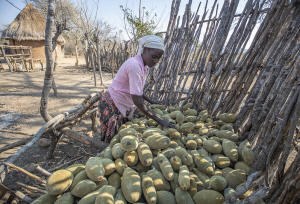An ancient African tree is providing a new 'superfood' yet local
harvesters are barely surviving
 Send a link to a friend
Send a link to a friend
 [September 18, 2024]
By FARAI MUTSAKA [September 18, 2024]
By FARAI MUTSAKA
Since childhood, Loveness Bhitoni has collected fruit from the gigantic
baobab trees surrounding her homestead in Zimbabwe to add variety to the
family’s staple corn and millet diet. The 50-year-old Bhitoni never saw
them as a source of cash, until now.
Climate change-induced droughts have decimated her crops. Meanwhile, the
world has a growing appetite for the fruit of the drought-resistant
baobab as a natural health food.
Bhitoni wakes before dawn to go foraging for baobab fruit, walking
barefoot though hot, thorny landscapes with the risk of wildlife
attacks. She gathers sacks of the hard-shelled fruit from the ancient
trees and sells them on to industrial food processors or individual
buyers from the city.
The baobab trade, which took root in her area in 2018, would previously
supplement things like children's school fees and clothing for locals of
the small town of Kotwa in northeastern Zimbabwe. Now, it's a matter of
survival following the latest devastating drought in southern Africa
worsened by the El Niño weather phenomenon.
“We are only able to buy corn and salt," Bhitoni said after a long day’s
harvest. "Cooking oil is a luxury, because the money is simply not
enough. Sometimes I spend a month without buying a bar of soap. I can’t
even talk of school fees or children’s clothes."
The global market for baobab products has spiked, turning rural African
areas with an abundance of the trees into source markets. The trees,
known for surviving even under severe conditions like drought or fire,
need more than 20 years to start producing fruit and aren't cultivated
but foraged.

Tens of thousands of rural people like Bhitoni have emerged to feed the
need. The African Baobab Alliance, with members across the continent’s
baobab producing countries, projects that more than 1 million rural
African women could reap economic benefits from the fruit, which remains
fresh for long periods because of its thick shell.
The alliance's members train locals on food safety. They also encourage
people to collect the fruit, which can grow to 8 inches (20 centimeters)
wide and 21 inches (53 centimeters) long, from the ground rather than
the hazardous work of climbing the enormous, thick-trunked trees. Many,
especially men, still do though.
Native to the African continent, the baobab is known as the “tree of
life” for its resilience and is found from South Africa to Kenya to
Sudan and Senegal. Zimbabwe has about 5 million of the trees, according
to Zimtrade, a government export agency.
But the baobab's health benefits long went unnoticed elsewhere.
Gus Le Breton, a pioneer of the industry, remembers the early days.
“Baobab did not develop into a globally traded and known superfood by
accident,” said Le Breton, recalling years of regulatory, safety and
toxicology testing to convince authorities in the European Union and
United States to approve it.
“It was ridiculous because the baobab fruit has been consumed in Africa
safely for thousands and thousands of years,” said Le Breton, an
ethnobotanist specializing in African plants used for food and medicine.
The U.S. legalized the import of baobab powder as a food and beverage
ingredient in 2009, a year after the EU. But getting foreign taste buds
to accept the new tang took repeated trips to Western and Asian
countries.
“No one had ever heard of it, they didn’t know how to pronounce its
name. It took us a long time,” Le Breton said. The tree is pronounced
BAY-uh-bab.

[to top of second column]
|

Loveness Bhitoni harvests fallen baobab fruit in Mudzi, Zimbabwe,
Thursday,Aug. 22, 2024. (AP Photo/Aaron Ufumeli)

Together with China, the U.S. and Europe now account for baobab powder's
biggest markets. The Dutch government's Center for the Promotion of
Imports says the global market could reach $10 billion by 2027. Le
Breton says his association projects a 200% growth in global demand
between 2025 and 2030, and is also looking at increasing consumption
among Africa’s increasingly health-conscious urbanites.
Companies such as Coca-Cola and Pepsi have opened product lines
promoting baobab ingredients. In Europe, the powder is hyped by some as
having “real star qualities” and is used to flavor beverages, cereals,
yogurt, snack bars and other items.
A kilogram (2.2-pound) packet of baobab powder sells for around 27 euros
(about $30) in Germany. In the United Kingdom, a 100-milliliter (3.38
ounce) bottle of baobab beauty oil can fetch 25 pounds (about $33).
The growing industry is on display at a processing plant in Zimbabwe,
where baobab pulp is bagged separately from the seeds. Each bag has a
tag tracing it to the harvester who sold it. Outside the factory, the
hard shells are turned into biochar, an ash given to farmers for free to
make organic compost.
Harvesters like Bhitoni say they can only dream of affording the
commercial products the fruit becomes. She earns 17 cents for every
kilogram (2.2 pounds) of the fruit and she can spend up to eight hours a
day walking through the sunbaked savanna. She has exhausted the trees
nearby.
“The fruit is in demand, but the trees did not produce much this year,
so sometimes I return without filling up a single sack," Bhitoni said.
"I need five sacks to get enough money to buy a 10-kilogram (22-pound)
packet of cornmeal.”
Some individual buyers who feed a growing market for the powder in
Zimbabwe's urban areas prey on residents' drought-induced hunger,
offering cornmeal in exchange for seven 20-liter (around 4-gallon)
buckets of cracked fruit, she said.
“People have no choice because they have nothing,” said Kingstone Shero,
the local councilor. “The buyers are imposing prices on us and we don’t
have the capacity to resist because of hunger.”
Le Breton sees better prices ahead as the market expands.

“I think that the market has grown significantly, (but) I don’t think it
has grown exponentially. It’s been fairly steady growth," he said. "I
believe at some point that it will increase in value as well. And at
that point, then I think that the harvesters will really start to be
earning some serious income from the harvesting and sale of this really
truly remarkable fruit,” he said.
Zimtrade, the government export agency, has lamented the low prices paid
to baobab pickers and says it's looking at partnering with rural women
to set up processing plants. The difficult situation is likely to
continue due to a lack of negotiating power by fruit pickers, some of
them children, said Prosper Chitambara, a development economist based in
Zimbabwe’s capital, Harare.
On a recent day, Bhitoni walked from one baobab tree to the next. She
carefully examined each fruit before leaving the smaller ones for wild
animals such as baboons and elephants to eat — an age-old tradition.
“It is tough work, but the buyers don’t even understand this when we ask
them to increase prices,” she said.
All contents © copyright 2024 Associated Press. All rights reserved |